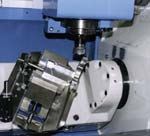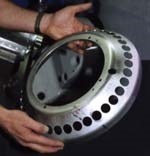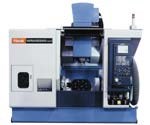Manufacturer Slices Cycle Time 80 Percent
Most of this company's work is machined to tight tolerances and super-high finishes. It builds, assembles, tests and then ships a complete product. The many multi-faceted parts being machined typically required several setups on different machines, often with cumbersome pallet and indexing devices.
Saint-Gobain Semiconductor Equipment (San Jose, California), a precision manufacturing and assembly operation for the semiconductor equipment industry, has always tried to apply the latest, most effective technologies to its operations. Recently, it became time to replace its aging milling centers with new machining technology.
Most of the company's work is machined to tight tolerances and super-high finishes. The company builds, assembles, tests and then ships a complete product. The many multi-faceted parts being machined at Saint-Gobain typically required several setups on different machines, often with cumbersome pallet and indexing devices.
Some of the prismatic parts and large-diameter parts were machined on a stand-alone horizontal milling machine with a pallet and a CNC indexer. This attempt to machine as many features and sides per setup as possible required several different part setups, and cycle times were too long. In addition, the cables and different controls necessary to control the indexer and the machine created an added burden, leaving cables running from the machining center to the indexer control.
The company needed a simpler approach. Its standard three-axis mills worked fine, but the more accurate machines were getting old; some were more than 12 years old and were starting to lose some accuracy. The company needed a multitasking machining system that offered greater capabilities.
Operating weekday shifts in swing operation and day shifts during the weekend, many of the machines at Saint-Gobain only see 4-hour idle times. To keep up with this schedule and the quickly changing market demands of the semiconductor industry, the company needed the most reliable, accurate and capable machining technologies. It also needed systems that could machine products primarily from 6061 and some 5052 aluminum alloys.
The Variaxis 200 from Mazak (Florence, Kentucky) was the solution. The 110-inch by 105-inch footprint of the Variaxis houses a spindle head that can travel up to 1,969 ipm in a 20-by 20-by 18-inch work envelope. Its integral tilt-rotary table can hold 300 kg parts 19.7 inches in diameter and 15.9 inches high. The table's A-axis and C-axis motion s of 150 degrees and 360 degrees, respectively, provide part maneuverability. According to the company, it offers five-axis movement to lower the setups needed to machine a complete, complex part from several to one. In addition, its fast rapid travels translated into shorter cycle times.
Previously, drilling the holes on HMCs had been a lengthy process. Transferring the pallet to the Variaxis provided many benefits. These included fewer tools to machine the final part, setups reduced from four to one and faster cycle times because of faster travel speeds. Now, the company produces a complete part that once took 40 minutes in just 8 minutes—an 80 percent reduction in cycle time.
The rigidity and speed of the system extended to other operations as well. For example, during a test run, a 9-by 6-by 6-inch block of aluminum weighing 30 pounds was roughed and finished in a single setup that included drilling and boring to create a detailed part weighing about 5 pounds. On a stand-alone horizontal mill it took four setups to create the same part.
The right tooling was an important issue in that particular operation. The company had tool reach and rigidity problems with the previous tooling. Saint-Gobain has been working closely with Kennametal on a new end mill that would suit the work the system needed to perform. The result was a new plunging tool proven out at 300 ipm. The tool worked so well that Saint-Gobain plans to increase the Z-axis travel speed from 300 to 500 ipm during production.
The part maneuverability possible on the Variaxis, with its rotational and angular worktable axes, is said to allow optimal cutting-tool usage. Saint-Gobain found the part accuracy impressive. In one setup, the machine cuts one face, rotates the part using the transom, then, using the same tool, cuts another face, explains the company. This method ensures perpendicularity, holding a true position of 0.0025 inch. In addition, a part that once required 45 minutes of cycle time now takes only 28 minutes for the removal of 25 pounds of metal.
The company says it also is pleased with the Mazatrol Fusion 640 control. Its engineers found the Mazatrol to be easy to navigate, making it that much easier and faster for them to get up to speed on using the machine.
Saint-Gobain was so impressed with the multi-tasking machining centers from Mazak, that it ordered four systems: two of the Variaxis and two of the Integrex. Currently, the Variaxis is used as both a production and development machine, producing production parts and proving out part designs. As the semiconductor market picks up, it will shift its operations into more of a production mode, says the company.
Today, managers keep their eyes open for any other part that fits the capabilities of the Variaxis. The parts destined for the Variaxis include multi-faceted, multi-shaped parts and block shapes. According to the company, anything that will fit inside the machine and can benefit from the 0-to 1,390-ipm rapid traverse will go directly to the machine.
Related Content
Inside an Amish-Owned Family Machine Shop
Modern Machine Shop took an exclusive behind-the-scenes tour of an Amish-owned machine shop, where advanced machining technologies work alongside old-world traditions.
Read MoreWhen Organic Growth in Your Machine Shop Isn’t Enough
Princeton Tool wanted to expand its portfolio, increase its West Coast presence, and become a stronger overall supplier. To accomplish all three goals at once, acquiring another machine shop became its best option.
Read MoreChoosing The Right Grinding Wheel
Understanding grinding wheel fundamentals will help you choose the right wheel for the job.
Read MoreVolumetric Accuracy Is Key to Machining James Webb Telescope
To meet the extreme tolerance of the telescope’s beryllium mirrors, the manufacturer had to rely on stable horizontal machining centers with a high degree of consistency volumetric accuracy.
Read MoreRead Next
3 Mistakes That Cause CNC Programs to Fail
Despite enhancements to manufacturing technology, there are still issues today that can cause programs to fail. These failures can cause lost time, scrapped parts, damaged machines and even injured operators.
Read MoreThe Cut Scene: The Finer Details of Large-Format Machining
Small details and features can have an outsized impact on large parts, such as Barbco’s collapsible utility drill head.
Read More.jpg;maxWidth=970;quality=90)










.jpg;maxWidth=300;quality=90)









.png;maxWidth=300;quality=90)







